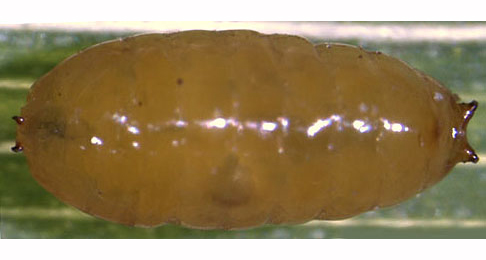|
||||||
|
TRIGONELLA. Fenugreeks. [Fabaceae] |
|
Twenty-one species of Trigonella are recorded in Britain. All are introduced and include Blue Fenugreek (T. caerulea), Sickle-fruited Fenugreek (T. corniculata), Fenugreek (T. foenum-graecum), Egyptian Fenugreek (T. hamosa) and Star-fruited Fenugreek (T. monspeliaca). Seven British miners are recorded on Trigonella. The polyphagous agromyzid Liriomyza trifolii has been recorded in quarantine in Britain (Pitkin & Plant in British leafminers). See also Liriomyza species in Glasshouses and/or Quarantine Interceptions. A key to the European miners recorded on Trigonella is provided in Bladmineerders van Europa.
|
Key for the identification of the known mines of British |
Note: Diptera larvae may live in a corridor mine, a corridor-blotch mine, or a blotch mine, but never in a case, a rolled or folded leaf, a tentiform mine or sandwiched between two more or less circular leaf sections in later instars. Pupation never in a cocoon. All mining Diptera larvae are leg-less maggots without a head capsule (see examples). They never have thoracic or abdominal legs. They do not have chewing mouthparts, although they do have a characteristic cephalo-pharyngeal skeleton (see examples), usually visible internally through the body wall. The larvae lie on their sides within the mine and use their pick-like mouthparts to feed on plant tissue. In some corridor miners frass may lie in two rows on alternate sides of the mine. In order to vacate the mine the fully grown larva cuts an exit slit, which is usually semi-circular (see Liriomyza huidobrensis video). The pupa is formed within the hardened last larval skin or puparium and as a result sheaths enclosing head appendages, wings and legs are not visible externally (see examples). See Key to non-Diptera. |
|||||||||||||||||||||||||||||
1a > Leaf-miner: Larva producing a short narrow linear mine not associated with the margin, which then develops into a conspicuous white blotch centred on the mid-rib. At the end of feeding the larva lies for one or two days along the mid-rib. Pupation external (Spencer, 1972b: 37 (fig. 114b); Spencer, 1976: 126, fig. 213A). Broad and short hook-like upper-surface corridor, ending in a little blotch in the centre of a leaflet. The blotch is upper-surface as well, but has some deep spots, giving the mine a mottled appearance when hold against the light. Frass in the blotch in a few large lumps. Pupation outside the mine. A short, broad gallery leading to a conspicuous, roundish white blotch in the centre of the leaf. The blotch is upper surface with full depth spots - comprising of large clumps of frass. Puparium reddish |
|||||||||||||||||||||||||||||
|
|||||||||||||||||||||||||||||
Agromyza nana Meigen, 1830 [Diptera: Agromyzidae]. |
|||||||||||||||||||||||||||||
1b > Leaf-miner: Mine linear, whitish, both upper and lower surface. Pupation internal, at the end of the mine with the anterior spiracles projecting through the epidermis (Spencer, 1976: 433). Upper-surface, less often lower-surface corridor. Frass in isolated grains. Pupation within the mine, in a, usually lower-surface, pupal chamber. A long whitish upper surface corridor, which eventually goes lower surface. |
|||||||||||||||||||||||||||||
|
|||||||||||||||||||||||||||||
Chromatomyia horticola (Goureau, 1851) [Diptera: Agromyzidae]. |
|||||||||||||||||||||||||||||
1c > Leaf-miner: Corridor leaf-mine in leaves. An upper surface linear mine with frass in conspicuous greenish strips, largely alternating at each side of the channel (Spencer, 1976: 241). Upper-surface, unbranched corridor, relatively broad from the start on, but only weakly widening subsequently. The fresh mine is bright green, but turns whitish, later brown, quickly. Frass in a wide green band in the centre of the corridor, with small black granules at either side. Pupation outside the mine. Forms an upper surface mine, with the frass in a green strips. |
|||||||||||||||||||||||||||||
 Liriomyza congesta puparium Image: © Willem Ellis (Bladmineerders van Europa) |
|||||||||||||||||||||||||||||
|
|||||||||||||||||||||||||||||
Liriomyza congesta (Becker, 1903) [Diptera: Agromyzidae]. |
|||||||||||||||||||||||||||||
1d > Leaf-miner: A distinctive mine primarily above mid-rib, with irregular short lateral offshoots into leaf blade. Pupation external (Spencer, 1972: 51 (fig. 172), 55; Spencer, 1976: 270, 271 (fig. 486)). Branched, whitish, upper-surface corridor; main axis overlying the midrib; side branches overlying the main lateral veins. (In Campanula and Phyteuma the mine is much less branched, sometimes nothing more than a corridor on top of the midrib). Frass in rather long strings. Usually the mines begins as a long and narrow, shallow, tortuous lower-surface corridor that ends upon the midrib but otherwise is not associated with the leaf venation. Often this initial corridor is filled with callus, and then even less conspicuous. Pupation outside the mine. A linear mine on the upper surface, usually following the midrib and showing side branches along the veins. The frass is in strings. |
|||||||||||||||||||||||||||||
|
|||||||||||||||||||||||||||||


